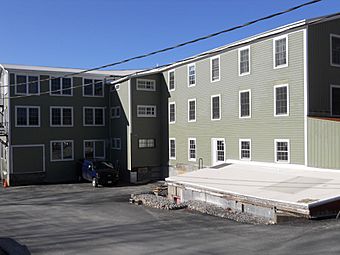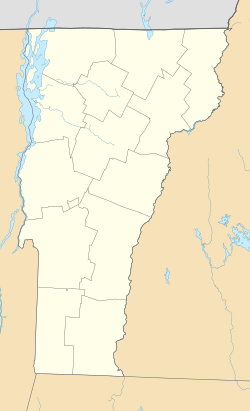H.C. White Company Mill Complex facts for kids
Quick facts for kids |
|
|
H.C. White Company Mill Complex
|
|
 |
|
| Location | 940 Water St., North Bennington, Vermont |
|---|---|
| Area | 12.6 acres (5.1 ha) |
| Built | 1887 |
| NRHP reference No. | 100000515 |
| Added to NRHP | January 11, 2017 |
The H.C. White Company Mill Complex is a historic group of factory buildings in North Bennington, Vermont. This place was once home to the White Company, a famous business started in 1879. They made special viewers and cards for looking at 3D pictures, called stereographs. They also created a very popular toy called the Kiddie-Kar, which was a three-wheeled wooden scooter for kids.
The company used these buildings from its start until it closed in 1935. The complex includes several buildings built between 1887 and 1919. Because of its important history, the complex was added to the National Register of Historic Places in 2017.
Contents
What is the H.C. White Company Mill Complex?
The former White Company Mill complex is located in North Bennington, right by the Paran Brook. This brook flows into the Walloomsac River. The complex has many buildings made of brick and wood. There's also a concrete dam built around 1900 across the brook, which created a pond.
Oldest Buildings and Main Features
The oldest building here is a three-story wooden building from 1887. It was built after an earlier factory burned down. The biggest building is a large three-story brick structure from the late 1910s. Other important buildings include a two-story office and a smaller two-story factory. Many smaller buildings are spread across the 12-acre site.
Who was Hawley C. White?
Hawley C. White grew up in North Bennington. He learned how to make optical lenses in New York City. In 1874, he came back to North Bennington. He continued making lenses and stereoscope viewers, working with B.G. Surdam.
Starting His Own Business
In 1878, White started his own company. He bought this property, which already had factory buildings. Sadly, these buildings were destroyed by fire in 1887. But White quickly rebuilt them.
In 1899, White expanded his business. He started making stereoscopic images himself. He sent photographers all over the world to take pictures of amazing places and things. His company's high-quality images made them one of the best producers of these 3D pictures for over ten years.
The Famous Kiddie-Kar
In the 1910s, White looked for new products to make. He began making wooden furniture for children. This included the very popular Kiddie-Kar, a three-wheeled scooter. In 1915, the company stopped making stereoscopes. They sold their huge collection of images to the Keystone View Company.
The H.C. White Company kept going until 1935. At that time, it faced financial trouble and had to close down.
What Happened to the Buildings After White Company Closed?
After the White Company closed, the buildings were used for many different things. They became office spaces, light manufacturing factories, and even homes.
New Uses and Renovations
After World War II, the buildings grew quite a bit. A printing press operated there, and new sections were added in 1959 and 1969. Later, a company called Chem Fab (which became St. Gobain) used the buildings.
From the late 1970s, the buildings helped small businesses grow. This was managed by the Bennington County Industrial Corporation. In 2007, a property development company called HRH Management bought the buildings. Since then, the buildings have been greatly updated. They followed special rules set by the National Park Service. Many industrial businesses still use the space, but many apartments have also been built. This has given these historic buildings a new and exciting future.



